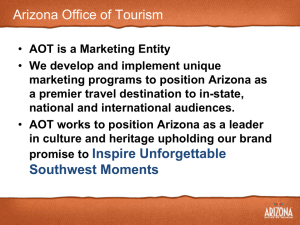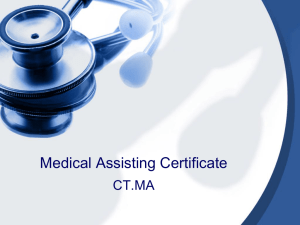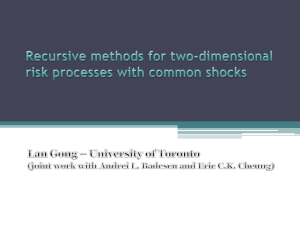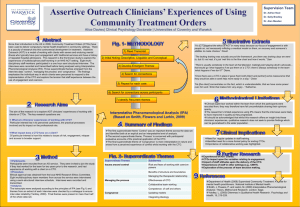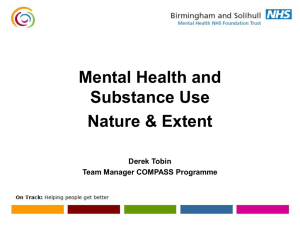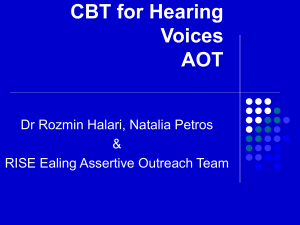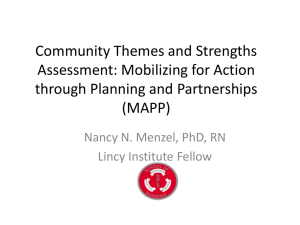A Slide Presentation Assisted Outpatient Treatment
advertisement
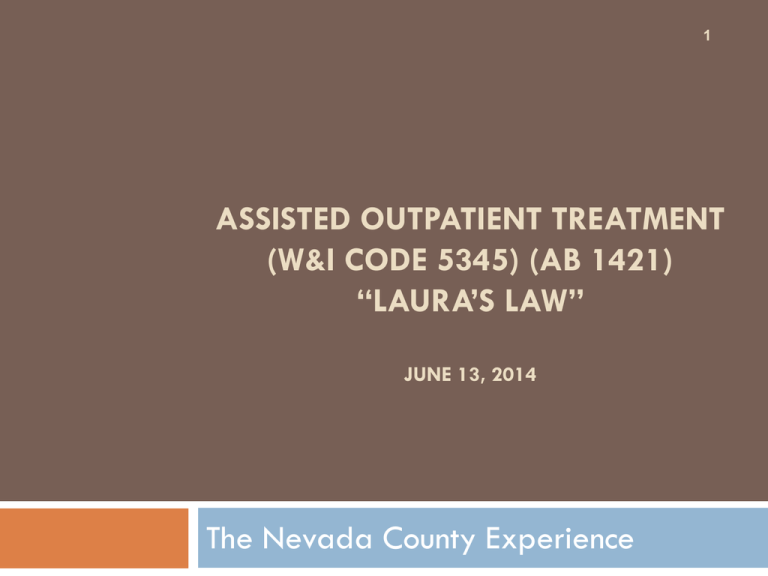
1 ASSISTED OUTPATIENT TREATMENT (W&I CODE 5345) (AB 1421) “LAURA’S LAW” JUNE 13, 2014 The Nevada County Experience Jan 10, 2001 2 • • • 3 people were killed by an individual with an untreated mental illness in Nevada County, including Laura Wilcox, “Laura’s Law” Several critically wounded Entire community closed down and fearful Stigma 3 • • • Not our intention to promote stigma of persons with mental illness We embrace recovery principles and the belief that all individuals can recover and live satisfying and productive lives We recognize that a small subset or persons with untreated mental illness, especially those with a cooccurring substance use disorder, may have a high potential to be dangerous to themselves or others Jan 1, 2003 4 • • • • California enacted court-ordered outpatient treatment, known as Assisted Outpatient Treatment (AOT), as an option for Counties Modeled after Kendra’s Law in New York 45 states have similar laws Resulting from a collaboration with Treatment Advocacy Center, parents of victim, and state legislators Nevada County Process 5 • • • No funding attached to legislation County resolved to use any available means to prevent future tragedies Mental Health Services Act (MHSA) funding was considered as possible funding source Nevada County Process 6 • • • Approval from Department of Mental Health to use MHSA funds to implement treatment components of AOT, May 2007 Board of Supervisor’s approval to implement AOT, April 2008 Implemented and began services, May 2008 Issues to Consider 7 • • • • • • • AOT is too expensive AOT violates civil rights Voluntary treatment is more effective than AOT AOT is not needed because we already have other interventions (e.g. 5150 and 5350) AOT is not effective because you can’t force medication AOT outcomes are not documented, and are no more effective than voluntary treatment AOT won’t work in counties with diverse cultural and ethnic populations AOT Criteria 8 County resident, minimum age 18 • Serious Mental Disorder (WIC 5600.3), (may include co-occurring disorders) • The person is unlikely to survive safely in the community • AOT Criteria 9 Lack of compliance with treatment, indicated by: • 2/36 months; hospital, prison, jail or • 1/48 months; serious and violence acts, threats, attempts to self /others (the element of dangerousness is a lower threshold than 5150 or 5350, not an imminent threat, not gravely disabled) AOT Criteria 10 • • • • • The person has been offered an opportunity to participate in treatment and failed to engage, or refused (therefore, voluntary services are not an alternative to AOT, as AOT requires that voluntary services have been offered and refused) Condition is deteriorating Least restrictive placement Necessary to prevent 5150 condition Will benefit from treatment WIC 5150 and WIC 5350 Criteria-Not Met 11 • • • These individuals do not pose an imminent danger to self or others, and do not meet WIC 5150 criteria These individuals are not gravely disabled, and so do not meet WIC 5350 criteria (Conservatorship) Therefore, simply attempting to hospitalize or conserve them is not a viable option 12 Who Can Request AOT? 13 • • • Any person 18 and older with whom the person resides The person’s parent, spouse, sibling or child, who is 18 or older A peace officer, parole or probation officer Who Can Request AOT? 14 • • • The director of a public or private agency providing mental health services to the person The director of a hospital where the person is being treated A licensed mental health provider who is supervising or treating the person AOT Program Requirements 15 • • • • Community-based, multi-disciplinary treatment, 24/7 on-call support, Individualized Service Plans, outreach, least restrictive housing options, mental health teams that use staff to client ratios of no more than 10 clients per 1 staff person Must include a Personal Service Coordinator (PSC) for full service coordination Team approach and capacity for frequent contacts For Example: Assertive Community Treatment (ACT) AOT Program Requirements 16 Stakeholder service planning and delivery. • Individual Service Plan • Comprehensive wraparound mental health, social, physical health, substance abuse, psychiatric, nursing, employment, and housing services • Use of practices demonstrated to be effective in achieving positive quality-of-life outcomes. • AOT Program Requirements 17 • • Specific strategies for AOT service recipients and stakeholders, such as families Comprehensive training and education program provided to AOT mental health treatment providers, law enforcement, probation, court personnel, hearing officers, and community at large. Voluntary v. Involuntary-SB 585 18 • • • Since Senate Bill 585 was enacted, we have clarification that specifically allows use of MHSA funds No locks, restraints, seclusion, or forced medication AOT services provided by the ACT Team are voluntary; the mandate, legal status, and order originate from the court No Forced Medication 19 • • • • Medication may be part of the court-ordered, individualized service plan Medications are not “forced”, but they are courtordered Court-ordered treatment is commonly provided throughout the California mental health system Almost all participants take medication Court-Ordered Treatment 20 Counties typically provide treatment to individuals with court orders for mental health treatment: • LPS Conservatees • Individuals on probation/parole • Parents ordered into treatment in dependency court Court-Ordered Treatment 21 • • • Mental Health Court participants Court Wards Court Dependents Court & Legal Process 22 3 components • Pre-hearing notice of investigation and hearing • Court hearings and due process requirements • Collaborative supervision of AOT after the court order Court & Legal Process 23 • • • County files a petition and the licensed mental health treatment provider may testify The petition must be served on: o Person who is subject to the petition o County Office of Patient Rights o Current health care provider appointed The petition must determine there is no appropriate/feasible less restrictive option Court & Legal Process 24 • • • • County provider must file an affidavit (declaration) with the court at 60-day intervals (or sooner if determined by the team and/or court) The declaration does not require a hearing, unless the court has set one in advance Affidavit reflects level of participation and whether the person continues to meet criteria. Includes individualized recommendations or modifications that may be discussed in court Provider role 25 • • • • Offers ACT services and supports Emphasis on partnership, client/family centered services, individualized plans, individual need and pace, no-fail, culturally competent, not withdrawn based on expectations of response No limitation on the engagement phase of services(this increases the likelihood of success) This phase includes monitoring person for increased risk or increased participation in services offered Provider Role 26 • • • High risk, not engaged and poorly coping; requires an emphasis on Outreach & Engagement and welcoming environments Advocacy and Empowerment Investigates/Assesses whether the person meets full criteria Provider Role 27 • • • • • Prepares documents for County Counsel in support of petition Provides Notice of Hearing to the individual Provides AOT/AACT treatment following court order Provides status reports to the AOT court team at 60 day intervals or less. Reports include level of engagement, successes, challenges and recommendation. Additional Provider Tasks 28 • • • • Collaboration: with law enforcement, probation and public defenders/private lawyers, conservator, County Counsel, other County Departments Support: in court and/or hospital settings, correctional facilities and in successfully completing all steps required of the individual by the court Collect MHSA and Milestones Of Recovery Scales data to measure outcomes Submit data to Nevada County and CA DHCS Additional Supports 29 • • • • • • • • Assist client with housing (emergency, transitional and permanent) Assistance with entitlements (Social Security, Medi-Cal, etc) Psychiatric medication services and outreach Medical linkage and services Community integration Employment and education support Substance Use Disorder counseling and treatment Life Skills training Providence Center AOT Data 30 Since May 2008: • 81 referrals for AOT evaluations ; 67 unduplicated individuals • 36 AOT court orders; 30 unduplicated individuals • 6 incomplete orders due to hospitalization, incarceration, or death • Approximately 5 people per year have received an AOT court order Providence Center AOT Data 31 • • 5 adversarial hearings (i.e. where the person appeared with counsel and challenged the petition.) 4 hearings where the person did not appear; an evidentiary hearing was held before the judge to present the evidence that the person met criteria. AOT Program Oversight 32 • • Report to State DHCS specific outcomes WIC 5349. “This article shall be operative in those counties in which the county board of supervisors, by resolution or through the county budget process, authorizes its application and makes a finding that no voluntary mental health program serving adults, and no children’s mental health program, may be reduced as a result of the implementation of this article.” • • Monitors programs to ensure training requirements are met Senate Bill 585 modified the original requirement Costs and Savings 33 • • • • • Actual cost per individual varies; budget for Fiscal Year 14/15 projected at $20,736/year/individual = same as ACT Team cost Average length of stay is 180 days $1.81 is saved for every $1 invested Bill Medi-Cal, Medicare, private insurance, patient fees for allowable services AOT costs are similar to ACT costs AOT Outcomes Are Similar to ACT Outcomes 34 • • • • • • • Fewer hospital days Fewer jail days Higher employment rates Less homelessness Overall cost savings Better treatment engagement Higher Milestones of Recovery scores Actual Outcomes: For 19 unduplicated individuals, for the most recent 12 months pre-treatment vs. 12 months post-treatment 35 • Psychiatric Hospital Days 510 days vs. 290 days post-treatment = 43.1% • Incarceration Days 687 days vs. 327 days post-treatment = 52.4% • Homeless Days 254 days vs. 117 days post-treatment = 53.9% • Emergency Interventions 18 contacts vs. 36 contacts post-treatment = 100.0% Actual Outcomes: For 19 unduplicated individuals, for the most recent 12 months pre-treatment vs. 12 months post-treatment 36 • • • Satisfaction Rating: 72.4% MORS Extreme Risk 38.9% 6.5% MORS Coping/Rehabilitating 0.0% 40.0% 2011 National Association of Counties Achievement Award 37 • • • reduction in actual hospital costs of $213,300 reduction in actual incarceration costs of $75,600 a net savings to the County of $503,621 for 31 months “The total AOT program costs of $483,443, plus the actual hospital and jail costs for 31 months of $136,200, was $618,643. Based on utilization data from 12 months to implementation of AOT, the projected hospital plus jail costs without AOT for the same 31 months would be $1,122,264, representing a net savings to the County of $503,621.” Final Thoughts 38 • • • • Three California Counties have BOS approval to fully implement AOT: Nevada, Yolo, and Orange (LA County AOT-light in one court) 45 states have adopted legislation to implement AOT AOT saves lives, protects civil rights, increases public safety, and improves the quality of life for the individual Provides treatment before an individual becomes gravely disabled, or does harm to self or others Final, Final Thoughts 39 • • • • AOT fills a gap in the treatment continuum AOT allows for a treatment option that is less restrictive than Conservatorship and locked inpatient care AOT is not a panacea, but does support the possibility of engaging some individuals in treatment that would not otherwise be possible It is possible to create a recovery based AOT program Contact Information 40 Michael Heggarty, MFT Nevada County Behavioral Health michael.heggarty@co.nevada.ca.us Carol Stanchfield, MS, LMFT Turning Point Providence Center carolstanchfield@tpcp.org Honorable Judge Thomas Anderson Nevada County Superior Court Tom.Anderson@nevadacountycourts.com Laura Wilcox 41
